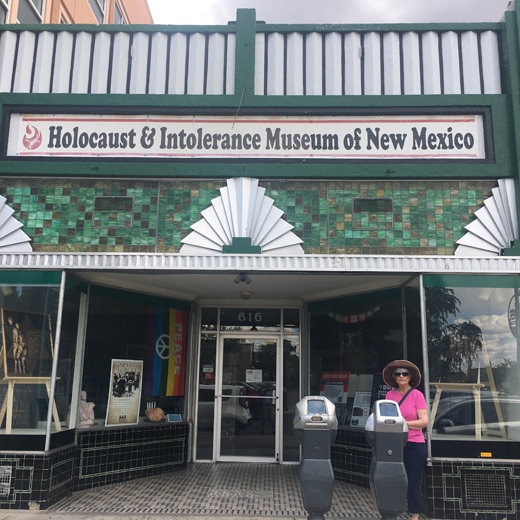
Story an photos by Oliver B. Pollak
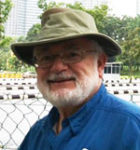
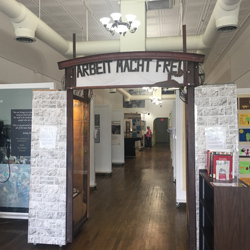
ALBUQUERQUE, New Mexico – We’re in Albuquerque for the 75th birthday of Dr. Steve, the father of my daughter-in-law Erika. Steve’s wine cellar with red wines dating back to the early 1980s was an added pleasure.
New Mexico’s Jewish history is more complicated than the rest of American Jewish history because of the existence of Spanish crypto or hidden Jews who arrived with the Spaniards in the 16th and 17th century. Modern New Mexico, a state with a 2010 census population of 2,059,179 has about 24,000 Jews. Albuquerque, the largest city, has a population of 558,000 with about 1,500 affiliated Jews among a total estimated Jewish population of about 7,000.
A critical mass of this size has the usual presence of Conservative, Reform, Jewish Renewal and Chabad Orthodox congregations as well as a Jewish Community Center, Federations and Anti-Defamation League. Then in 2001 the Holocaust & Intolerance Museum of New Mexico was added to the cultural and educational attractions for local residents and tourists. It was founded by Holocaust survivor and successful banker Werner Gellert, who stated, “Indifference to the persecution of others always has tragic consequences.”
I visited the Museum twice during my Albuquerque sojourn and interviewed volunteer Marcia Rosenstein, a retired school librarian, who arrived in Albuquerque in 1992 and is a member of Reform Congregation Albert. She has served as a Museum volunteer in several capacities. Lyn Berner has been the Director since January 2006.
In the summer of 2009 the Museum moved to its current location at 616 Central Avenue, two blocks from its former home. It is a conventional 5,000 square foot commercial bay that had been at various times a grocery store, and a location for filming episodes of Breaking Bad. It is a remarkable facility and tells us much about museum design, exhibitions, public appeal and aspirations. The basement contains a 5,000-volume library. They are looking for larger quarters, perhaps 15,000 square feet in a renovated mall.
The officers and the board represent the diverse Albuquerque community including including Christians, Jews, Muslims, ‘conversos’, and members of the LGBT community. They publish a quarterly newsletter The Herald. There is a part-time education outreach director and archivist and several docents accommodate about just under 4,000 visitors a year. The uniqueness of not having a gift shop will soon end. A cabinet has been ordered and local artisans are crafting appropriate objects.
The Jewish experience of discrimination and hate, the location of New Mexico on America’s southern border, and the rich Hispanic past, place the museum in the position of curating Europe’s and America’s past, contemporary affairs, and setting an agenda for the future. It’s all about educating the public about human rights. This is a great challenge in a state that ranks next to last in the country for public education.
As visitors enter the Museum they are confronted with the hated expression above the door; Arbeit Macht Frei (“Work Sets You Free”) and seven banners that raise the question of being a Bystander or an UPSTANDER who is “an individual who sees wrong and acts; a person who takes a stand against an act of injustice or intolerance.” The panels cite statistics about discrimination, homelessness, the LGBT community, children being separated from their families at the border, gang violence, abuse, involuntary labor, and sex trafficking. Since 2015 anti-Semitic incidents in New Mexico jumped from 8 to 24 in 2019, and we are only half way through the year. In the 21st century we will not stand by in the face of hate crimes motivated by race, religion, gender identity and sexual identity.
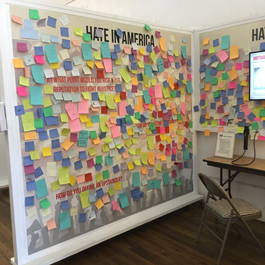
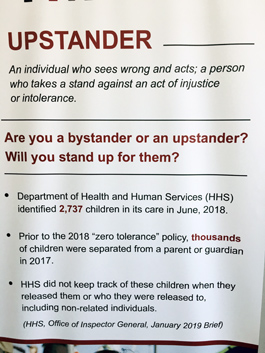
Religious congregations are taking pro-active positions to assist asylum seekers. Anti-Muslim hate groups and neo-Nazi groups can only make gains if bystanders predominate over Upstanders.
The museum exhibits are arranged on two sides of the bay. The right is dedicated to the Jewish experience: Holocaust, Kristallnacht, Eastern Europe, and the Shoah. The end of the displays includes remnants: a doll house depicting German Jewish homes in the 1930s; a Holocaust Torah from Czechoslovakia, one of 1,565 that survived the Holocaust and were sent to Westminster Synagogue in London, and then distributed around the world on permanent loan; and a refugee’s steamer trunk that traveled 13,500 miles from Czechoslovakia in 1938 to New Mexico in 1987. It was donated to the Museum in 2011 and joined smaller iconic refugee suitcases.
On the right side are interpretive exhibits: Hate in America comprises three 7-foot-high panels of post with a colorful array of Post-It messages about bullying, cliques, shaming, humiliation, and other harmful interactions.
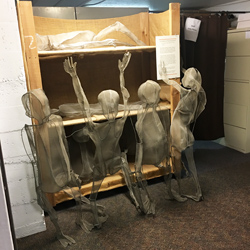
There are panels on genocide of Christian minorities, the Rwanda genocide, the African American experience from enslavement through segregation and the civil rights movement, and the semantics of What is Propaganda?
The basement is the place for past exhibits that have no space on the main floor, including Children of the Holocaust sculpture which had a prominent space in the first location, and may be resurrected in a new larger museum.
The Museum has been successful in obtaining donations, grants, and state funds to accomplish its mission such as the Upstander concept. It is developing a membership base. If you happen to be visiting Albuquerque take the opportunity to stop by between 11 a.m. and 3 p.m.
*
Pollak, a professor emeritus of history at the University of Nebraska Omaha, and a lawyer, is a correspondent now based in Richmond, California. He may be contacted via oliver.pollak@sdjewishworld.com
Thank you Professor Pollak for the wonderful article about our museum. You beautifully captured the message of our museum. It was a pleasure and an honor to have discussed our little but very important museum with you.